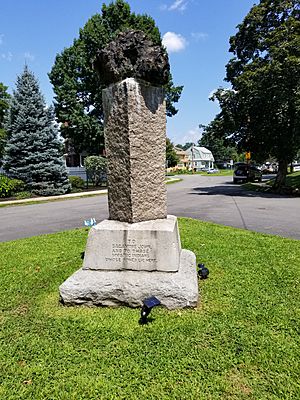Wonohaquaham facts for kids
Quick facts for kids
Wonohaquaham
|
|
|---|---|

Sagamore John burial monument in Sagamore Park in Medford
|
|
| Pawtucket leader | |
| Preceded by | Nanepashemet |
| Succeeded by | Wenepoykin |
| Personal details | |
| Died | 1633 Winnisimmet |
| Parents | Nanepashemet and "Squaw Sachem" |
| Known for | Pawtucket Sachem |
| Nickname | Sagamore John |
Wonohaquaham, also known as Sagamore John, was an important Native American leader. He was a Sachem (a chief) of the Pawtucket people when English settlers first started arriving in his lands.
Contents
Sagamore John's Early Life
Wonohaquaham was the oldest son of Nanepashemet and the Squaw Sachem of Mistick. After his father passed away, Wonohaquaham became the sachem of Mishawum. This area covered a lot of land near the Mystic River. Today, this land includes places like Chelsea, Charlestown, Malden, Everett, Revere, Somerville, Woburn, and Stoneham. It also included parts of Medford, Cambridge, Arlington, and Reading.
Wonohaquaham lived in a place called Rumney Marsh, which is now Chelsea. In 1631, a writer named Thomas Dudley said that Wonohaquaham led about 30 to 40 people. His group often moved from one place to another.
Working with English Settlers
People described Wonohaquaham as being "gentle and good" towards the English settlers. In 1627, he allowed them to settle in Charlestown. He was also known for warning the colonists if other Native American groups were planning attacks.
By 1631, Wonohaquaham, whom the colonists called Sagamore John, could speak English. He even wore English clothes and lived in houses built in the English style. He also showed interest in the Christian religion. However, because of this, other Native Americans sometimes made fun of him.
A person named Edward Howes hoped that Wonohaquaham would become "civilized and a Christian." But Wonohaquaham chose to stay with his Pawtucket people instead of joining the settlers. He tried to use the English court system to solve problems. Sometimes it worked, and sometimes it didn't. For example, in 1631, he received some cloth and money from a settler after the settler's helper accidentally burned two Pawtucket homes.
Sagamore John's Death
Around December 2, 1633, Wonohaquaham and about thirty of his people died from smallpox. This was part of a big outbreak that also killed Massachusett chief Chickatawbut the month before. The disease caused a lot of harm to the Native American population in the area.
Before he passed away, Wonohaquaham asked Reverend John Wilson to raise his two sons. He wanted them to learn about the Christian faith. Only one of his sons survived the smallpox outbreak. Wonohaquaham left his special shell beads (wampum) and personal items to his mother. He left his land on Powder Horn Hill in Chelsea to his son. He also gave gifts to John Winthrop and other colonists.
Where Was He Buried?
In 1888, workers in West Medford found the remains of 18 Native Americans. At the time, people thought these might be Wonohaquaham and some of his followers. A tall monument was built near this spot, which is now called Sagamore Park.
However, historical records suggest that Wonohaquaham was cared for and buried by Samuel Maverick in Winnisimmet (today's Chelsea). This is different from where the monument is. Wonohaquaham's father, Nanepashemet, was killed in 1617 in Medford, and his burial site was found there in 1619. So, Sagamore Park might actually be Nanepashemet's resting place, not Wonohaquaham's.

